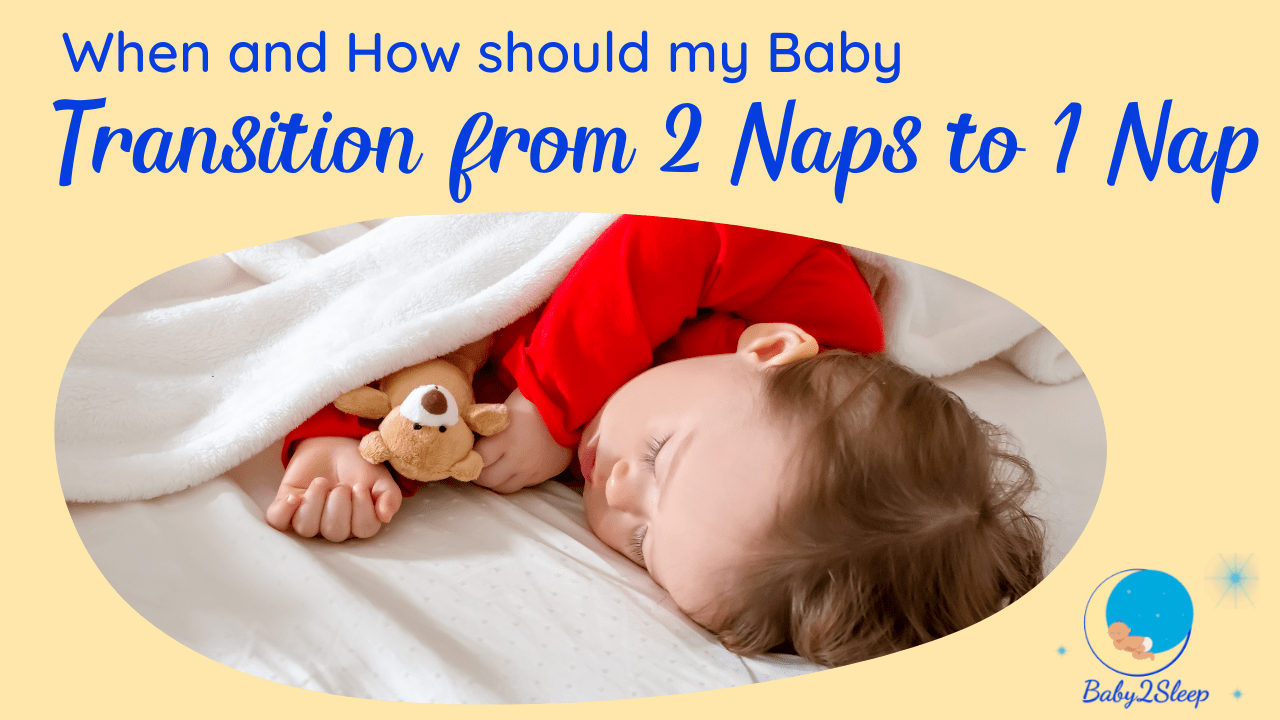
When and how should my baby transition from 2 to 1 nap?
How and when should my baby transition from 2 to 1 nap?
Nearly all babies go through the stage where 1 nap isn’t enough, but 2 naps are too many. So, what can you do about this? How do you know whether your child is ready for 1 nap, and if so, when should that nap be and for how long? The 2 naps to 1 transition is probably the trickiest one to master so you need to make sure your baby is ready for it when you start.
How do you know when they are ready to transition from 2 to 1 nap?
There are a few signs to look for, as follows:
- Your child’s age. The transition normally takes place between the ages of 15-18 months. Some are ready a little earlier and others a little later, but not as many babies fall outside that window as you may think. You may think you have spotted the signs but it could be just a blip if they are significantly younger than this.
- Sleeping through the night and consistently getting 10 and a half to 11 hours uninterrupted sleep. (Easier said than done if you have never had a good sleeper but try to get this as close as
possible before making the change). - Taking longer to fall asleep each time for the first nap of the day
- Falling asleep quickly but only taking a short nap, (meaning they were possibly under tired
- Taking a really long nap in the morning and then refusing to take the afternoon nap
With all of the above signs, make sure you notice a consistent change – something that happens for 7 days or more, and then you know it’s not just a blip.
Common mistakes with the nap transition
We all want to feel that our baby is moving to the next stage and maturing, but be careful not to go too fast. Each child will develop at their own rate, and changing nap schedules too soon may have knock on effects on the sleep that your child gets at night. These are problems that I often see:
- Thinking your child is ready earlier than they actually are. I know a lot of parents think their little one is ready at 11 months, but I can promise you now, this is very much the exception and dropping a nap at this age can often lead to more problems further down the line.
- Thinking that because they occasionally refuse to go to sleep for the morning nap, they mustn’t need it any more. (We all have our off days where me may be a little grumpy, like to test, challenge and rebel, so don’t let the odd day be your guide).
- The same goes for the afternoon nap, The world is an exciting place and she may just have the odd overstimulating day.
- Your child misses a nap one day, falls asleep very quickly at bedtime and then sleeps through the night for the first time ever. You would naturally think that cutting the nap would mean she sleeps through, but this may be very short-lived.

Making the transition: What to expect and how to combat it
Once your child is the right age and you have started to see regular signs that they are ready to drop a nap, then it’s time to start making the transition. Even if this is what your child needs, it may not be as easy – babies crave routine and a change from the norm can often cause disruption at first.
Expect there to be a bit of crankiness and grumpiness. Your child will be tired at times, so it is to be expected. What you don’t want is for your tired baby to become an overtired baby. This then opens up other sleep challenges with potential behavioural challenges for you to combat, which will make the transition longer and harder.
Solution – early to bed. You can go anything up to 1 hour early and it shouldn’t cause your child to wake up earlier. Bedtime is the optimum time for catching up on missed sleep.
Expect that some days they will have 2 naps, other days they will have 1, but how will you know which days to do the 2 naps?
Solution – stop clock-watching as much and look for sleepy cues. To expect a toddler to go from 2 naps a day to 1 nap every day instantly may be asking too much. It may be that you allow the morning nap but cut it short to still get the long afternoon nap, alternatively, it may be a long morning nap with a cat nap in the afternoon to break up the wakeful time and get her through to bedtime.
How to make the change:
There is no one way to do this and no set length of time it takes. It is very much down to your baby as to how you help her transition. Some take to it in 5 days, others can take weeks. My own little girl took 6 weeks before it was completely embedded.
The most common way is to try and shift the morning nap a bit later each day, so if it is normally 9am, move it half an hour later over the course of days to weeks to get it to sit around 12noon, (or when fits with the nursery schedule, if nursery put them down at 1 for their nap, there’s no point you trying to set if for 12 as your child will just get overtired on nursery days and it will sabotage your nights. This works the other way too, if you aim for a 1 pm nap and nursery do 12, your child will get overtired waiting for a 1 pm nap on non-nursery days).
While you are making the change, you may find the afternoon nap becomes more of a struggle, especially the later the morning nap gets, so you may find yourself doing early to bed in place of the afternoon nap.
If this way doesn’t work for your little one, you may find that you let her nap in the morning but cut it short after 30 minutes, then keep the afternoon nap around 1/1:30pm, with the aim being to gradually bring the afternoon nap earlier and cut the morning cat nap.
Another thing to consider is what happens at nursery. Some nurseries move babies to 1 nap before they are ready, just because it is the time the other children sleep. You may find they take to this transition fine at nursery, but non-nursery days seem to be a major struggle. If this does happen and the change is enforced before your child is fully ready, you may need to keep to your standard 2 naps at weekend so they can catch up on any missed sleep at nursery and do early to bed on nursery days.
Here is an ideal schedule for a one nap day
7am wake up,
12 noon nap
2-2:30 wake up
7pm bed.
These times may need to be shifted a little if you have a natural early bird who likes to wake at 6am. This may mean the nap sits closer to 11:30. You don’t want to go too early as that will then cause you problems at bedtime as the wakeful window will be too long.
For more information
The 2 to 1 Nap transition is covered as part of my Build your Own Sleep Plan for the 12-24 months age range – You can find out more about this course here Build Your Own Sleep Plan
I have also covered the other nap transitions from birth onwards in this video – All about Naps and Nap Transitions
If you’re not sure about anything, feel free to ask me. I run live Q&As on my Facebook page every Monday at 8pm, you can send me a message or book a free 15-minute chat with me.
Sorry, the comment form is closed at this time.



Pingback: Choosing a Nursery - Baby 2 Sleep